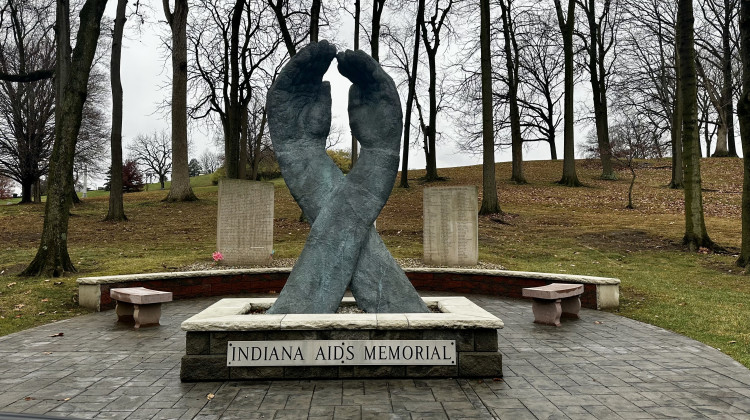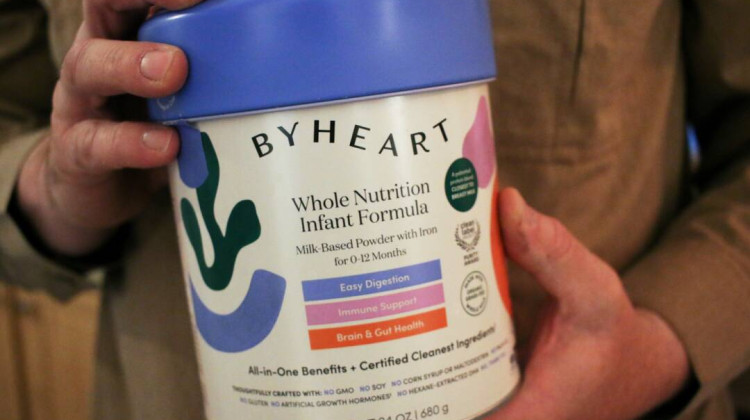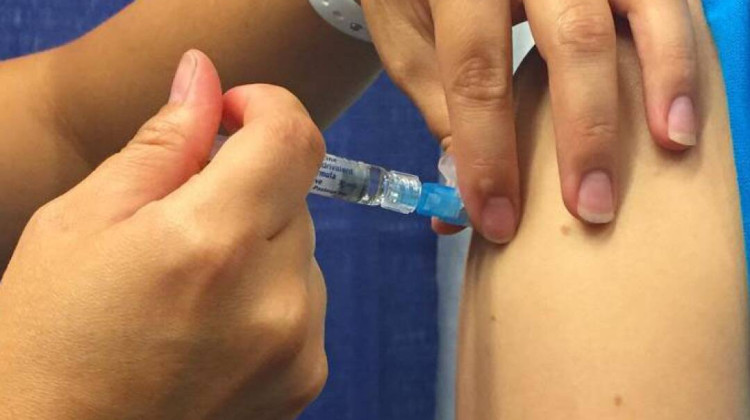
In southeast Michigan, Marisa Springstead has sought more intensive mental health services for her son, eventually filing suit. She’s still fighting. The photo has been blurred to shield the name of the school district.
(Erin Kirkland, Bridge Michigan)By Robin Erb with Bridge Michigan and Carter Barrett with WFYI's Side Effects Public Media
On a tree-lined street, behind a welcoming front porch with an American flag and cushioned furniture, a mother tries to calm her teenage son.
At the moment, the boy is jamming a dog toy at the throat of his chihuahua mix.
“Don’t force it, don’t force it,” she says, as the boy shoves harder, pushing the tiny animal back. “No, no, no, no, no, no. Safe. Safe.”
Marisa Springstead’s son is 15 years old. He now tops 200 pounds. He has broken her nose and twisted her wrist, she said. His most recent attack, last week, sent her to the emergency room. He once beat his grandmother with a leather belt.
Nearly every door in their home has a lock. Springstead keeps chimes on the boy’s bedroom window to alert her if he tries to leave. The kitchen has been cleared of knives.
For more than four years, Springstead has pleaded with local health officials for more help managing her son’s acute mental illness. In desperation, Springstead sued the state of Michigan in 2017. A federal judge ordered intensive, in-home care and an on-call intervention staff that can quickly respond in an emergency.
Too often, Springstead said, that doesn’t happen, with staff slow to respond to emergencies or missing shifts entirely. “I am sore,” she said recently, “exhausted and tired of living in fear daily and on eggshells.”
Across the Midwest, there are not nearly enough psychiatrists, therapists or direct-care staff to treat a rising tide of young people spiraling into crisis. For the most acute cases, there aren’t enough inpatient beds, either. It’s a story echoed across much of the country. This was true even before COVID-19.
But over the past 16 months, as the pandemic closed schools and isolated young people, a mental health system held together by good intentions and Scotch tape is failing tens of thousands of children in places like Michigan and its neighbor, Indiana, leaving many families to manage despairing children on their own, particularly in rural areas.
Depression and attempted suicides are up. Teens who once might have battled through anxiety over grades or insecurities tied to social media are increasingly ending up in hospital emergency rooms, where they can stay as long as a month — without treatment — as nurses or administrators try to find beds in psychiatric centers. When they fail, these young patients are returned home. For untold others, just getting in to see a psychiatrist or therapist can be daunting.
“The beauty with kids is that when they're young, we intervene early, we can really make a difference,” said Dr. Zakia Alavi, a child psychiatrist at LifeWays Community Mental Health in Jackson, Michigan.
But the reality?
“Every morning,” she said, “there is like a hole in the pit of my stomach because I know I have no beds, and I am going to send at least three psychotic kids home on a wish and a prayer.”
Bridge Michigan and Side Effects Public Media interviewed scores of families, doctors, nurses, hospital administrators and mental health experts and gathered hospitalization data and research studies documenting the strain that COVID has added to an overburdened system.
What is true in Michigan is true in Indiana, two Midwest states with similar, middle-of-the-road investment in mental health resources. We found plenty of parents like Springstead: disheartened and scared, but determined to find treatment for a child they love, day after grinding day.
Some parents told us they want their names used, their families photographed, the grimmest details shared. The situation is so dire, they said, they feel obliged to put a face on their agony to persuade politicians and health leaders to improve the system, if not for them, then for families very much like theirs.
While most young people with mental illness do not present a threat of violence to others, what these families share is a daily pressure-cooker existence and, often, a mix of helplessness and guilt.
“Everyone keeps saying ‘You've done so much,’” said Meg Hartz of South Bend, Indiana, who spent years seeking residential care for a son with bipolar disorder.
“And I think, if I have done so much, why didn't I do better?”
In her living room, Hartz looks down at her phone. She swipes through photos of her boy. She says the images show who her son really is.
There he is, standing over the stove making cauliflower mac-and-cheese, his grandpa’s favorite. Swipe. Holding his infant nephew at a baptism, grinning into the camera. Swipe. Sitting at a campfire showing off a really crisp marshmallow.
“This is him,” she says, motioning. “Look at the smile. This is who he is. And he needs help.”

Brothers, Sisters, Sons And Daughters
In early May in Michigan’s Upper Peninsula, Keweenaw County Sheriff Curt Pennala opened the department’s Facebook page and posted a snapshot of the twisted remains of a truck that a suicidal young person plowed into a grove of trees at 100 mph.
Rushed to the hospital, the driver was examined, deemed not a threat to themself and returned home the same day, he said.
“This does not sit well with us,” the sheriff typed in frustration.
It was one of several recent cases involving his deputies in which people attempting self-harm were evaluated by local mental health staff.
“Do you want to take a guess on how many received treatments? None,” Pennala wrote. “When are we going to have a meaningful discussion on the broken Mental Health system in Michigan?”
“These are our brother(s), sisters, sons and daughters who are crying out for help.”
The Upper Peninsula — more than 300 miles across — has no child psychiatrists. No pediatric psychiatric beds, either. None. The problem is compounded by a shortage of behavior therapists, counselors, social workers and other support staff, forcing U.P. families to take children to Wisconsin or downstate when their condition deteriorates, said Dr. Stuart Johnson, a family doctor at UP Health System ‒ Marquette who is part of an effort to recruit general psychiatrists to the U.P.

“Child psychologists are like unicorns, especially up north here,” said Jane Shank, executive director of the Association for Children’s Mental Health, a nonprofit that provides support to Michigan’s families.
Shortages also plague swaths of Michigan’s northern lower peninsula and much of the Midwest, including Indiana. And even when a specialist is nearby, securing an appointment can be brutal.
In Indiana, hospitals report a record number of patients seeking mental health care. Even before COVID, providers reported months-long waitlists. Now, with increased demand, these waitlists are being stretched longer.
“We're in a crisis situation,” said Holly Wheeler, executive director of Family Voices Indiana, which connects families to resources. “It's buckling under the weight of all of these people who really, truly need treatment.”
As more young people find themselves in distress, there are fewer pediatric facilities to treat the most severe cases.
A 2019 study, before the pandemic, found a 54 percent jump in psychiatric visits among U.S. children between 2011 and 2015. That included a stunning 2 ½-fold increase involving adolescents who were suicidal.
Yet in the decade between 2008 and 2018, the overall number of child inpatient units shrank by 19 percent and the number of pediatric beds fell 12 percent, according to a study published in the journal Pediatrics this month. The decrease was even worse in rural areas.
A separate study, released in May, found more children with mental health issues faced extended stays in hospital emergency rooms as they waited for residential treatment. This was especially true for Hispanic children.
At Munson Healthcare Manistee Hospital in West Michigan, it often falls to ER nurse Kari Zoscsak to find inpatient beds for children with acute mental illness.
“I literally sit at the desk, where there's all this activity going on, and as time allows, try and make these phone calls,” she said.
“Usually, it’s ‘Sorry, we’re full. There are no beds today,’” Zoscsak said. Another day goes by. She tries again.
“You just hold your breath, and you hope there’s a bed and that someone will give this kid a chance.”

By the state’s own account, Michigan needs 43 more psychiatric beds to meet even the minimum needs of the state’s youth. But the state’s estimate may not be accurate because it’s based on the assumption that all of Michigan’s 334 authorized psychiatric beds for young people are in use.
They are not. The reason: There are simply not enough staff to operate them, experts say.
According to a 2019 state survey, 70 percent of the state’s licensed pediatric beds were used that year — which is in itself a misleading and constantly-changing number, said Laura Appel, senior vice president here at the Michigan Health & Hospital Association, an industry group.
Everyday reality and what’s on paper aren’t the same.
“It depends on what day it is,” Appel said.
‘I Don’t Know Why I’m Crying’
Bridge Michigan spoke with parents and grandparents in every corner of Michigan — from the U.P. to Grand Rapids, metro Detroit and its northern suburbs to a wooded swatch of mid-Michigan.
In a home among the farm fields of the Upper Peninsula, a grandmother is raising an 11-year-old who spent her early childhood in a drug house. She said the girl had been deprived of food and safety and was often left to care for her baby brother. It left scars, and relentless distrust.
“She’s listening to everything,” the grandmother said. “She’s looking at you, but she’s listening to the conversation in the hall. She was hurt and she won’t be hurt again… (She’s) a survivor.”
The girl is combative at school and at home. The grandmother wears long sleeves at work to hide her injuries. “There isn’t anything in this house that hasn’t been destroyed,” she said. Rocks put in the gas tank, a stabbed couch, slashed clothing.
School and mental health workers know the family well.
“I want you to envision getting papers thrown at you and 90 percent of the time it’s about what your kid has done wrong,” the grandmother said. “‘She hit somebody.’ ‘She punched somebody.’
“I want help,” she said. “But there is no help."
Que Jewelz, of Highland Park, a city within the city of Detroit, first realized her daughter was in pain when at age 14, the teen would come home from school in tears. The mom went to her room and held her.
“She’ll say ‘Mom, I don’t know why I’m crying. I can’t stop.’
“There’s a word for it,” said the mom. “Helpless. As a mother, you just want to take away the pain. As a mother, you just want to take away the hurt.... I’ve cried myself to sleep many a day.”
Her daughter, Symone, is now 17, a talented singer who said she wants to contribute to the public conversation on young people with mental illness. She wants her name attached to her story, and her mother supports her decision. When in deepest despair, Symone has attempted suicide, and acted out. Her mother recalled a time when police Tasered her daughter to get her under control. It hasn’t been easy.
“When they are in a state, they hope you die,” Jewelz said.
“They hate you. And then you have to turn around and take them to the hospital and sit with them because there are no beds and if you leave this child, you don’t know if they will try to kill themselves again.
“I will tell you that I have said more than once, ‘I just can’t do this anymore.’”

Families with children in crisis often don’t know where to turn. They call hospitals, suicide hotlines and residential facilities — sometimes spending hours or days on the phone passed from one place to another.
Sometimes the advice is just this: Call 9-1-1.
A mother in northern Michigan said her young adult daughter told her last month she was contemplating suicide after her boyfriend took his own life. For days, the mother tried to get help, with no success.
The daughter is stabilized now, but the mother is nervous.
“She’s being kind of silent again,” she said. “That’s when you worry.”
A mother in West Michigan said she often spends hours a day talking to school officials and community mental health officials seeking help for her autistic son, 11, who’s had severe depression and anxiety during COVID.
“It’s exhausting. But if I give up, I’ve given up on his future,” she said.
“The system failed my child. I will not fail him.”
Forging A Life Worth Living
Springstead, the mother of the volatile 15-year-old, stood under the shade near her porch recently, watching her son shoot baskets, then jump on the trampoline — attempts to burn off some energy.
These moments at the end of a school day are tough. Sometimes her son’s mood is good. Other times, it’s like on this day, when he opened the front door, complained how a bird at school made so much noise he tried to kill it then began taunting his dog.
The mother opened her phone to find a video she recorded years ago. It showed the boy charging at her moments after she hit the “record” button.
He slaps her, screams, kicks. He tears at her hair, and forces her face into the couch cushions.
Off-camera, the voice of a mental-health worker can be heard: “First you need to work,” she tells the boy, “and then you get food.”
“Bitch,” he screams.
He was 11.
And yet after sharing the video, Springstead said her son’s worst episodes do not offer a full portrait. He’s a boy who still loves comic book characters and after-school snacks and movies. He loves to talk with people; he craves friends. In the same moment he tells her he hates her, he often says “I love you.”

Springstead is not much different from many parents, said Simon Zagata, an attorney with Disability Rights Michigan, which is pressing the suit to get more mental-health services for her son.
“That's what's most striking to me is they're not looking for a way to get out of helping their kid,” Zagata said. “They're doing this because they want to help their kid, and they need these” services.
When the boy was younger, a psychiatrist at Hawthorn Center, a state-run child and adolescent psychiatric hospital, recommended his release after three months if there were “intensive in-home services and staffing” in place to help the family.
In 2018, U.S. District Court Judge David Lawson signed off on a settlement agreement that required in-home aid, respite care for the mom and a crisis intervention staff that would respond in an emergency within an hour — two hours, tops.
But according to Springstead, staffers sometimes don’t show.
In 2019, she filed a report with the service provider after staff missed a shift. Her son, she wrote, “has been melting down, grabbed my hair, ripping it, hitting me, chasing me, tantrums, tried to break glass table, slamming doors, tried to twist my arm around.”
She drew a thick arrow to the bottom of the page: “Where are my supports? Staffing?” she wrote.
The provider, Oakland Community Health Network, cannot comment on specific cases nor confirm which families receive services, said spokesperson Christine Burk.
Speaking generally, the agency said in a statement, it faces the same staff shortages as others around the state — a problem “exacerbated by the COVID-19 pandemic.” Among other actions, OCHN is raising pay for some direct-care workers who assist families in homes. It has also tried to launch a “youth mobile crisis team” to de-escalate crisis situations, but “due to the COVID-19 pandemic, staffing continues to be a barrier.”
Standing in her backyard on a recent afternoon watching her son, Springstead said there are times she feels guilty, “jealous of the fact that sometimes I need downtime. Because I can't be the good mom and give him quality (attention) if I'm burnt out 24-7.”
Now watching as her son crumbles on the trampoline, demanding frozen yogurt, she suddenly looks away as she wipes her face.
“I don't think he's gonna have a life worth living in,” she said.
“I worry. I worry about other people's behaviors towards my son and I don't want him in jail because he didn't ask to be born…”
The teenager is screaming now.
“I want a relationship with my kid,” she said. “I want a good one. I don't want to argue. I don't want to fight.
“I love him.”
This story is the first part of a three-day series produced by Bridge Michigan and WFYI's Side Effects Public Media in collaboration with the Institute for Nonprofit News. The project was made possible by a grant from the Robert Wood Johnson Foundation with additional support from INN's Amplify News Project and the Solutions Journalism Network.
To read other stories from the project, click here.
 DONATE
DONATE








 Support WFYI. We can't do it without you.
Support WFYI. We can't do it without you.